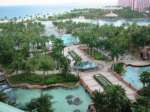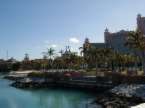| Travel Tips |
|
Before You Go
Airline Tips Hotels Cruise Line Tips Rental Car Tips |
| Home | USA | Canada | Caribbean |
|
Caribbean Aruba - Bahamas - Barbados - British Virgin Islands - Cayman Islands - CubaDominican Republic - Grenada - Martinique - Puerto Rico - St Vincent & the Grenadines BahamasArea: 5380 sq miles (13,940 sq km)Population: 294,982 Capital city: Nassau (pop 190,000) Language: English 




The Bahamas archipelago consists of some 700 islands and nearly 2500 small islets or cays sprawled across roughly 100,000 sq miles (259,000 sq km) of ocean. The islands stretch 750 miles (1200km) south from Walker's Cay, about 75 miles (120km) east of Palm Beach, Florida, to the Ragged Islands, which lie 50 miles (85km) northeast of Cuba. In all this vastness, the islands together add up to no more than 5385 sq miles (13,940 sq km) of land. The Bahamas is a year-round destination. Incessant trade breezes ensure pleasant temperatures, so unless you're visiting the southern isles, which get infernally hot in summer (June to August), weather isn't a major factor in determining when to go. The best time to come is the warm, breezy summer, when the water is so warm you can linger in it for hours. Mid-winter temperatures in the northerly and westerly isles can be surprisingly cold. In summer, the rainy season extends from May to November, when hurricanes are a slim possibility. The so-called 'peak season' runs from mid-December to mid-April, when hotel prices are highest. Nassau Nassau, the nation's capital, is steeped in modern American ways but has an undeniable quasi-Caribbean flavor. It exudes a special charm, imparted by a blend of Old World architecture and contemporary vitality. The center of touristic affairs is the waterfront, a beehive of activity when the ships disgorge their hordes. The historic downtown has many well-preserved 18th- and 19th-century buildings. Parliament Square is surrounded by the country's major government buildings.Paradise Island is connected to Nassau with a bridge. It has great beaches and over-the-top resorts. Tropical plant fanciers can browse over 300 species at the lush Royal Victoria Garden. The heart of the shopping district is Bay Street, where you can shop at the largest straw market in the world. Grand Bahama Grand Bahama is the second most popular destination in The Bahamas - meaning that it's largely overrun with North American snowbirds and its attractions are geared appropriately. The island's most popular area, Freeport/Lucaya, is a modern, planned affair with little charm and less that's authentically Bahamian. On the western end of the southern shore, Freeport is home to the Rand Memorial Nature Centre, which boasts excellent horticultural displays and nature trails, and the Garden of the Groves, a lush Eden filled with 5000 species of exotic plants and shrubs from around the world. Abacos The boomerang-shaped Abacos chain is the second-largest land mass in the country and comprises Abaco (the main island) and the Abaco Cays, a necklace of dozens of smaller cays. The Sea of Abaco, the protected waters in the cays' lee, is a hot spot for yachters. Instead of large, showy hotel resorts, the Abacos boast homey cottages and inns on talcum-fine beaches or alongside the many marinas. |